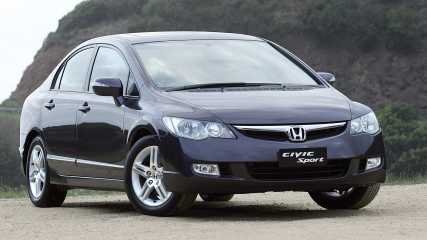Used Honda Civic review: 1995-2012
By Ewan Kennedy · 03 Aug 2012
Honda Civic began as a small car but increased in size over the years to become a small-medium by the period we are considering here.Because of the expansion in body size Honda also imports a smaller model, the Honda Jazz. Those who loved the smaller Civics of old may care to check out the Jazz. The Honda Civic has long had a reputation for build quality and reliability and this has lifted it a notch or two in the image stakes in Australia.Civic is a Japanese design in sedan format, with a fair bit of European input in the hatchback. The latter is built in England, the sedans in Japan or Thailand, the Civic petrol-electric hybrids are all made in Japan.Build quality doesn’t appear to be dependent on the country the Civic is manufactured in because the Japanese head office keeps a tight rein on the output of the factories. Interior room in the Honda Civic is good without being outstanding. There is space for four adults but in reality the rear seat is probably best left to children.Boot space is fine. Sedans are longer than hatches and most of this extra body size is put into a larger luggage area. There is some loss of boot space in the hybrid due to the installation of a large battery, but it’s better than many hybrids in this area.The Honda Civic is easy to drive and park thanks to light controls and good feel for the driver. These cars are popular with suburban users, but can be used on the open road, although bumpy secondary roads in the bush can cause a rough ride at times in older Civics as they have relatively short-travel in their suspension. Later models, from 2006, are better than the older ones.On smooth and moderate roads the Civic offers the sort of relaxed noise and vibration levels that are generally only found in cars from the next size class upwards. Engine sizes in the standard Civics are 1.6 litres and 1.7 litres in the older models; rising to 1.8 and even 2.0 litres in the current versions, introduced in 2012. The 2.0-litre engines are fitted to the sportier Civics and give plenty of performance.The semi-race Civic VTi-R, sold from 1996 until 1999, is very quick and is a delightful hot four. However, its engine only has a capacity of 1.6 litres and you have to work vigorously at the gearbox to keep it high in the rev range. If you’re not a keen driver you may find it frustrating and should perhaps avoid it. But if you do love pushing a car hard all the time then a VTi-R should definitely be on your short list.Five-speed manual gearboxes are standard in most models. Four-speed automatic transmissions are offered in all except the sporting Civic VTi-R. A five-speed auto is used in the eighth-generation Civics, launched at the start of 2006.The Civic Hybrid was introduced to Australia in early 2004 and is less extreme than previous Honda hybrids. As a result it’s more favourably priced. It has significantly lower pollutants from the exhaust as it runs a small 1.3-litre petrol engine, as well as an electric motor.The automatic fitted to the Civic Hybrid is a continuously variable transmission (CVT). Repairs and servicing can be relatively expensive. Spare parts also used to fall into that category, but Honda has worked hard with its parts network in recent years and things have improved considerably on the later Civics.Civic is reasonably simple mechanically so a good amateur mechanics can do a fair bit of the work themselves. Having a workshop manual at hand makes a lot of sense. Don’t attempt to carry out repairs to safety related items unless you have top class experience.Insurance costs are generally reasonable, with few companies making any real differentiation for the sportier versions of the Civic. Which is a surprise for such a little hotshot, it probably hasn’t sold in sufficient numbers to have come up on the radar of the insurance guys, let's hope it stays that way.Bodywork should be undamaged and free from rust. A Civic that has been poorly repaired after a smash may turn rusty later. Make sure the engine starts promptly and responds quickly and positively to the throttle. If possible arrange to start it when it’s cold after an overnight stop. Any engine that hesitates when revved suddenly should be treated with suspicion.A worn engine will smoke from the exhaust when it is driven hard after a period of idling. A conventional automatic transmission should be crisp in its changes and not hold onto any gear for too long. A continuously variable automatic transmission feels different in its operation so have an expert drive it if you are not confident it’s working correctly.The clutch pedal should be smooth in its operation. All manual gear changes should be light, positive and quiet. Problems will show up first on fast down changes, usually when going from third to second. Make sure the brakes pull the car up without any pulling to one side and that no one wheel locks while the others are still rolling freely.Look for Civics with a full service history as many belong to people who are very fussy about their cars.










